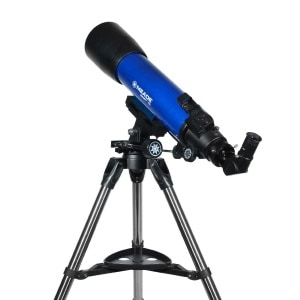
This makes them ideal for viewing such deep-sky objects ( DOSs) as nebulae, star clusters and galaxies. They are the instrument of choice for deep space and wide field viewing on account of their large apertures and superior light gathering abilities.
Reflector vs refractor telescope plus#
Newtonians are a great value telescope and comparability cheaper then reflector, but as mentioned reflector are superior viewing tools collecting up to as much 9x more light, Newtonians also tend to be bulkier but less longer then reflectors, another plus for reflecting telescopes is that they have no chromatic aberration.Reflector telescopes use mirrors and are usually short and wide in appearance. Newtonian reflectors are generally the least expensive telescope because, unlike the lenses of a reflector, only one surface of a mirror needs careful positioning and polishing, less expensive glass also is used. Given the relativity low cost they do make good entry level telescopes before scaling up. If you live in densely populated area and are planning using backyard telescope, these may not be your best option, they The aperture is not as good as reflectors if your main purpose is to view plants clearly, reflectors will suit your needs better.

The design is optimized for visually observing faint deep sky objects such as nebulae. Light enters the tube and gets reflected by the parabolic mirror back up to the top of the tube where there is a small diagonal mirror that bounces the light out the side of the tube thus Newtonians are easy to manufacture and low-cost compared to reflectors due to needing less glass material. They have A fat tubes with a parabolic mirror at the bottom. Some false color but an achromatic lenses resolves this issueĪlso called Newtonians, reflecting scopes are the best bang for the buck. Mechanically robust little alignment required If you’re into astro-photography, an achromatic lens is a must with a focal point of f/10 Reflector produce the highest contrast of any telescope, which makes them superb for visual observation of fine detail on the Moon and planets, especially reflector with achromatic lenses, the achromatic lens refactors show virtue zero false color, even at lower focal point f/6 or f/7, images are super sharp, and the contrast is virtually perfect. Unfortunately, they are difficult and expensive to manufacture for large diameter versions (i.e larger aperture), so they are expensive. They are simple to use and understand, need less maintenance and typically give very sharp views. This is the oldest style of telescope and has many advantages. Quick break down: This type of telescope has a long, slender tube with a lens at the front that “refracts” the light from the sky. Now that’s out of the way, let’s focus on some specifics of the two main types of telescopes available for backyard stargazers-reflector, reflector. You can, for example, see dozens of galaxies beyond our own Milky Way through a scope with 80 mm aperture from a dark location… they will be faint, but you will see them. Otherwise, the images of anything other than the Moon and Jupiter will be way too blurry and fuzzy. Your first scope should have an aperture of at least 80-90 mm.
A telescope with a larger aperture collects more light, gives you a brighter and clearer image, and lets you see finer detail that have you going ‘Wow’. As mentioned in “Most Powerful Telescopes for Home Use’ a telescope’s most important feature is its aperture i.e the diameter of its light-collecting lens. Which Telescope Is Best Refractor Vs Reflectingįirst of all, don’t buy those cheap telescopes that advertises amazingly-high magnification, mounted on an unsteady spidery like tripods that causes the image of any object to shake and vibrate until you start to feel nauseated, don’t worry about the magnification.


 0 kommentar(er)
0 kommentar(er)
